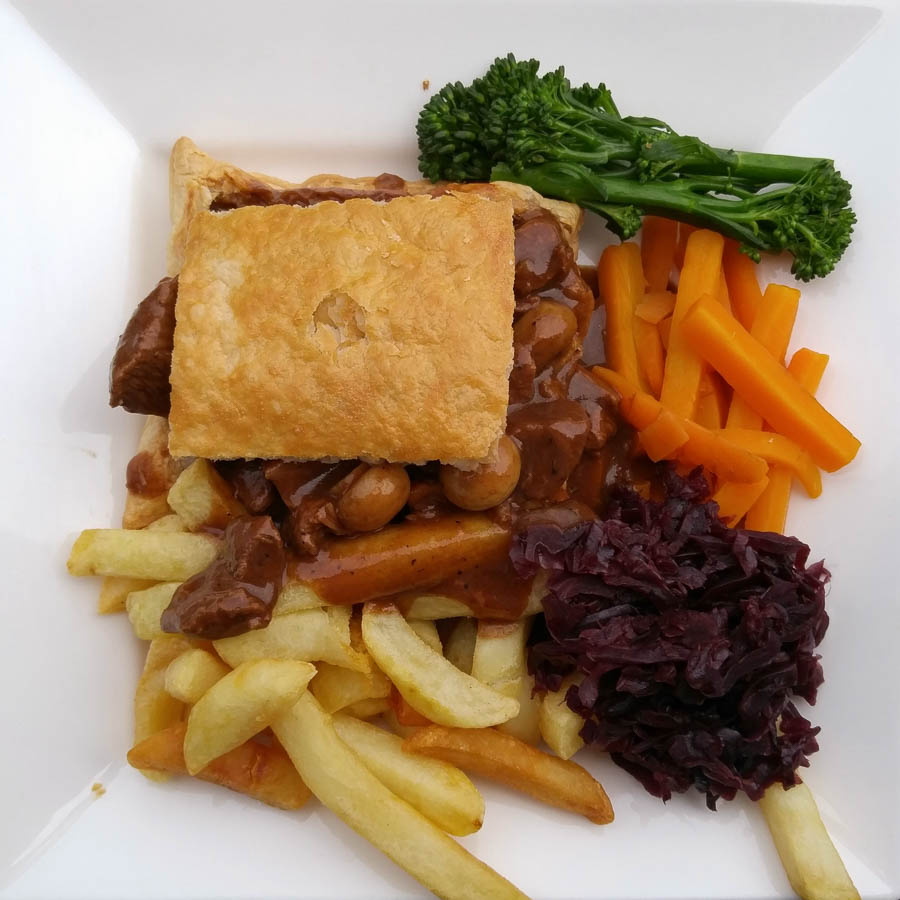As I offloaded the photos from Windy City Ribfest from my phone, this was in the same batch:

That's a steak and ale pie from The Greyhound Pub in Aldbury, Hertfordshire, this past Sunday. And it was much better than any of the ribs I had this evening.
Chicago actually has more than one ribfest. There's the main one in Lincoln Square, the big one in Naperville, and the ugly stepchild going on right now at Lawrence and Broadway.
Yes, Windy City Ribfest, I'm talking about you.

The "fest" is tiny, with just 6 rib vendors, three of them in such close proximity that the lines get mixed up and people trying to walk down the street nearly step on dogs' tails crossing them. And of the 6 vendors, none is spectacular.
I tried two $8 samplers, one from Porky Chicks BBQ and the other from our old friend Chicago BBQ. They were both meh. Tasty, sure; but not as epic as the bones I had from Piggery last month, or Mrs. Murphy's. And the organizers are so disorganized they don't even have a website.
Parker and I attended really only because it's about a 15-minute walk from my house. Otherwise I would skip it, as I may do next year.
But hey, even mediocre ribs are tasty.
I've listened to Minnesota Public Radio's A Prairie Home Companion off and on for most of its 42 years on the air. Tonight, coming home from the grocery store, I caught the last hour or so of Garrison Keillor's last show. And I got a little misty.
Scott Simon reflects:
The Lake Wobegon that Garrison Keillor has brought to life and built word by word, in millions of imaginations, is not a rustic refuge from the modern world. It has been gentle, but edgy, midwestern, but not middlebrow, calm but scarcely dull. People get sick, grow scared, pass through, and pass away in Lake Wobegon, to live on in stories.
For 42 years, Prairie Home Companion and Garrison Keillor's monologues have turned radio from a medium some considered to be faintly old-fashioned into a new form—an art, I'll even dare to say—of telling a story that a new generation downloads today.
In a line of work that always looks for what's flashy and new, Garrison Keillor created a rare thing out of the radio waves that skip through the air and disappear into the night: something that endures.
And it was a good show.
Right around the corner from where I'm staying I found this: I don't believe I need to eat anything else today.
I don't believe I need to eat anything else today.
A couple of things happened in the 10 hours since I got on a plane today:
Only two of these are a result of Thursday's Brexit vote. But all three of these affect me.
OK, I'm going to go find some curry.
Canadian writers Pat Kelly, Peter Oldring, and Chris Kelly nail it:
Oy.
OK, I am completely ribbed out. Yesterday I had 14 bones, today 12, which I think exceeds a full slab by a few.
Five of those bones (two yesterday, three today) were from The Piggery, because they were my favorites yesterday. Today they had a tiny bit less magic. Still 3½ stars, but not the 4 from before. They're still my favorites from this year, though.
I also sampled:
- Austin's Texas Lightning, who had a meaty tug-off-the-bone sample with some nice char. 3 stars.
- BBQ King Smokehouse gave me a better-than-expected sample with a tangy sauce and smoked meat that fell right off the bone. 3½ stars.
- Celtic Crown had a decent showing, but nothing that would drag me out there. Decent meat, but very sweet sauce, otherwise just OK. 2½ stars.
It's also 29°C with a gross dewpoint, and it was even hotter at the festival. That might have affected my scoring today. It was hot yesterday, too, but it didn't feel as sticky.
It turns out there are more ribs in my future, even this month. But I think I'll skip the fest tomorrow and have some light salads and fruit instead.
Yesterday I inadvertently swapped the names of two rib vendors. I remembered the ribs correctly, just mixed up where they came from. Tonight when I go for Round 2 I'll (a) bring note paper and (b) get another sampler from Piggery.
Wow. For the first time since August 2014, I just saw the Cubs win a baseball game at Wrigley. Astounding. And with back-to-back home runs in the 5th.
I can report they still play "Go Cubs Go!"
The Toronto Symphony Orchestra has created brilliant listening guides for audiences:
Hannah Chan-Hartley is the managing editor and musicologist at the Toronto Symphony Orchestra (TSO). She oversees the production of the orchestra’s various printed programmes, from designing layouts and writing and editing content, to the creation of its intriguing ‘listening guides’ with graphic designer Gareth Fowler.
A deft mix of text and graphics, the guides can be read while listening to the performance, their layout visualising the thematic progression of the music, indicating the keys in use, what instruments feature and, using morse code-like notation, their duration.
Check out the graphics themselves on the Creative Review or percussionist Chester Englander's Twitter feed.
That said, since childhood I've really enjoyed Peter Schickele's approach: